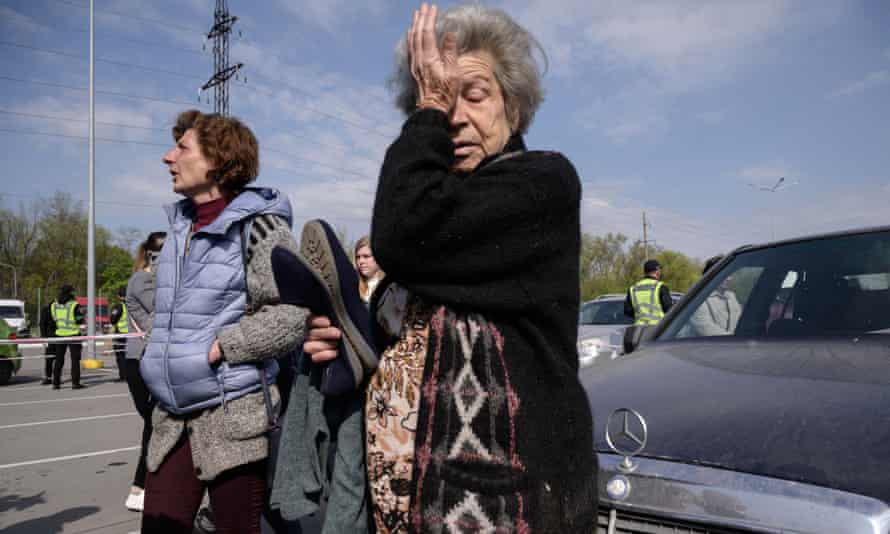A first group of civilians trapped for weeks inside the Azovstal steelworks in Mariupol was expected to reach a Ukrainian-held city on Monday, as authorities planned more evacuations and survivors told of horrific conditions inside the plant.
Hundreds of people remain trapped in underground bunkers and tunnels beneath the sprawling industrial site – the last stronghold of resistance to Russia’s siege of the devastated southern port city – which Russian forces resumed shelling overnight.
“The situation has become a sign of a real humanitarian catastrophe,” Ukraine’s deputy prime minister Iryna Vereshchuk said. President Volodymyr Zelenskiy said about 100 civilians should arrive in the city of Zaporizhzhia on Monday.
“For the first time in all the days of the war, this vitally needed green corridor has started working,” Zelenskiy said overnight. Some evacuees were initially taken to a village held by Moscow-backed separatists, but were expected to be allowed to continue to Ukrainian-held territory if they wanted.
The head of the Donetsk military administration said more evacuations under a UN/Red Cross plan were due to begin on Monday morning, with one Russian news report putting the number of civilians still in the plant at more than 500.
One evacuee, Natalia Usmanova, 37, said after leaving the steelworks that she became hysterical whenever the bunker started to shake. “I was so worried it would cave in – I had terrible fear,” she told Reuters, recalling widespread terror and a lack of oxygen underground.
Some who were not sheltering in the steelworks also managed to flee without assistance. Anastasiia Dembytska said she took advantage of the brief evacuation ceasefire to leave with her daughter, nephew and dog.
She said she had to cross countless checkpoints to reach Zaporizhzhia, waiting 18 hours outside before being allowed to pass. Another woman arrived in a funeral van saying she left Mariupol earlier and had been hiding in a basement in a nearby village.

A UN spokesperson, Saviano Abreu, said civilians arriving in Zaporizhzhia, about 140 miles (230km) north-west of Mariupol, would get immediate support, including psychological services. A Médecins Sans Frontières team was already in place.
There were no apparent plans to pull out the remaining Ukrainian forces still holed up in the plant, however, thought to number up to 2,000 and include members of the Azov regiment, the national guard, marines, border guards and other units.
One of the steelworks’ defenders, Denys Shlega, commander of the 12th Operational Brigade of Ukraine’s national guard, said Russian forces resumed shelling the plant on Sunday evening as soon as the civilians were evacuated.
Shlega said several hundred civilians remained trapped alongside nearly 500 wounded soldiers and “numerous” dead bodies. “Several dozen small children are still in the bunkers underneath the plant,” he said. Sviatoslav Palamar of the Azov regiment called for wounded fighters to be evacuated too.
Mariupol is a key Russian target because its capture would deprive Ukraine of a vital port, open up a land corridor to Crimea, which Moscow seized from Ukraine in 2014, and free up troops for what has become the main focus of the invasion: achieving full control of the eastern Donbas region.
Ukraine’s military command said on Monday Russia had redeployed several battalions from Mariupol to the heavily bombarded town of Popasna in the Luhansk province of Donbas, with the towns of Rubizhne, Sievierodonetsk, Slovyansk and Barvinkove also coming under heavy attack.
“I don’t even want to speak about what’s happening to the people living in Popasna, Rubizhne and Novotoshkivske right now,” said the Luhansk regional governor, Serhiy Gaidai. “These cities simply don’t exist any more. They have completely destroyed them.”
Zelenskiy’s office said on Monday at least three people were killed and another three, including a child, were wounded in Luhansk over the last 24 hours, with another four wounded in shelling in neighbouring Donetsk. Another two died in Orikhiv in the Zaporizhzhia region, further west.
Western officials say Russia is advancing slowly in its eastern offensive and has captured some villages, but is inflicting heavy civilian casualties through indiscriminate bombing. Ukrainian forces are fighting village-by-village and have retaken ground in places.
“Everyone understands that we must hold the line here,” Lt Yevgen Samoylov of the 81st Brigade told Agence France-Presse as his unit rotated out of the frontline near the town of Sviatohirsk. “We cannot let the enemy move closer. We try to hold it with all our force.”
The UK defence ministry said more than a quarter of the 120 “battalion tactical groups” – about 65% of Moscow’s total combat strength – deployed in Ukraine may now be “combat ineffective” due to personnel and equipment losses. “It will probably take years for Russia to reconstitute these forces,” it said.
Ukraine’s defence ministry said its drones had destroyed two small Russian Raptor patrol boats in the Black Sea, while the governor of the Russian region of Belgorod reported two explosions in the early hours, the latest in a string of fires and blasts in recent weeks at ammunition stores and fuel depots in the area.

